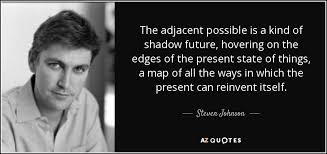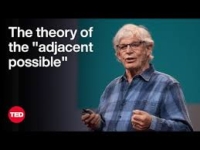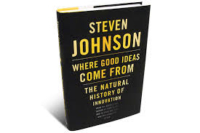
Just about two years ago, I published a blog post that revolved around the idea of the adjacent possible. Then, I was interested in how it helped me combine what I was learning about climate change from an old friend, David Orr, and evolution from David Sloan Wilson, whom I had not yet met.
I find myself returning to the idea now because, in the two years since I wrote that first post, the adjacent possible has become central to the work we will be doing in creating a Peacebuilding Starts at Home movement which we will be rolling out and inviting you to join in August.
That initiative will have a number of features but will focus on building diverse, grass-roots support in its first months. That’s where the idea of the adjacent possible has helped me focus my thinking.
The Idea
Since I doubt that you remember every last word of that original post even if you had read it carefully at the time 😁, let me spend a few paragraphs refreshing your memory 🙈.
 The idea was first developed by the evolutionary biologist and complexity scientist Stuart Kauffman. He started by pointing out something that seems obvious in retrospect but wasn’t clear at the time. Species do not evolve by making huge adaptations because they can’t. They can only adopt options that are readily available to them through genetic mutation and the other tools that shape evolution, all of which are way too complicated to go into here.
The idea was first developed by the evolutionary biologist and complexity scientist Stuart Kauffman. He started by pointing out something that seems obvious in retrospect but wasn’t clear at the time. Species do not evolve by making huge adaptations because they can’t. They can only adopt options that are readily available to them through genetic mutation and the other tools that shape evolution, all of which are way too complicated to go into here.
The idea was then adapted applied more generally fifteen years ago by the science writer Steven Johnson in his book, Where Good Ideas Come From which he recently updated in this interview he gave after launched his Substack of the same name a few months ago.
His version has the same bottom line when applied to new technologies or, in my csse, to new social movements. Change and creativity rarely happen as a result of huge leaps. To use a term one finds a lot among complexity scientists as well as evolutionary biologists, progress “emerges” as a result of small steps that lead to other small steps that lead to other small steps until truly dramatic change—a paradigm shift in my way of putting things—occurs.
Johnson took that idea and applied it in other settings, including in those that involve what David Sloan Wilson and others refer to as social or cultural evolution. Here, human are unique in that, unlike any other species, and we can shape how we think and act.
As wonderful as the idea is, the adjacent possible is a murky and hard to define concept when you get to the kinds of issues I’m interested in, something you can see in Johnson’s now famous definition:
The adjacent possible is a kind of shadow future, hovering on the edges of the present state of things, a map of all the ways the present can reinvent itself.
Still, the adjacent possible matters. Individuals and, especially, entire societies, rarely make major changes in one fell swoop. In my favorite language, social paradigm shifts do happen, but they take place gradually as a result of a series of incremental changes whose impact build off of each other. Thus, you couldn’t have smart phones until you had touch screens, wireless input from virtual keyboards, high speed internet access, and the like.
 Of course, some incremental changes are bigger than others as we saw in the recent Supreme Court decisions that legalized marriage equality and overturned Roe v. Wade.
Of course, some incremental changes are bigger than others as we saw in the recent Supreme Court decisions that legalized marriage equality and overturned Roe v. Wade.
Nonetheless, the point remains. More often than not, focusing on what you can accomplish in the here and now and then building on it later on makes sense strategically even when the situation seems to demand radical change, which many people feel is the case today.
The Adjacent Possible and Peacebuilding: What Not to Do
That leads to a first conclusion which I think of in baseball terms.
If you are behind by ten runs and no one is on base, it doesn’t make sense to dream about getting it all back right away by swingomg’’’’’’’’ for the fences, especially if, like me, you have never hit a four-bagger in your life.
There is no such thing as a ten-run home run even if somehow I became reincarnated as Aaron Judge!
Time after time, people have presented me with proposals that could change the world and do so quickly. In fact, I heard about one the other day that calls for sweeping policy change and would “only” cost several tens of millions of dollars to get off the ground. Even if the funds were available (and they’re not), it is never clear how we “get there from here” given what I’ve seen in any of these proposals.
The Adjacent Possible and Peacebuilding: What to Focus On
Thinking in terms of the adjacent possible leads one to think in terms of the “shadow future” and “all of the ways in which the present can reinvent itself.”
And it is definitely ways in the plural.
In fact, while I was writing this piece, I took time away from my keyboard so that Gretchen and I could attend the first meeting of our Rotary Club’s new committee charged with finding new concrete peacebuilding projects we could work on with other Rotarians. There are literally dozens of things we could do with Rotarians in other clubs in our part of Northern Virginia or elsewhere the country where we already have connections. We don’t have to reach all 800,000 Rotarians in the United States. Since our club only has twenty members, we couldn’t do so if we wanted to.
What we can do is identify the clichéd low-hanging fruit—Rotarians whom we already know might be intrigued by adding a peacebuilding component to their existing service projects. Once we’ve done that a few times, we (and they) can reach out to other, more skeptical Rotarians. And to members of other service clubs. Or to others who can help make the shadow future a lot less shadowy.
This is not the kind of incremental change that David Sloan Wilson got me thinking about again when he told me that he had just read Herbert Simon’s autobiography. Simon and other political scientists who did pathbreaking work on decision making and incremental change and were at the peak of their popularity when I was in grad school used terms like muddling through or satisficing in ways that anticipated part of what Kauffman and Johnson had in mind with the adjacent possible.
But they also had what you might think of as a transformative goal in mind, something systems theorists call a North Star. We don’t just do the best we can at the moment. As noted earlier, we learn what we can from the experience and build on it in ways that keep inching us closer to our end goal—in this case, building peace in the United States
And for Peacebuilding Starts at Home?
OK, I hear you cry out. Enough with the abstract ideas. What are you actually planning to do with this.
First, as we realized in our Rotary meeting, it probably doesn’t matter which issues or which populations you start with. In the Peacebuilding Starts at Home case, we will invite no more than forty trusted partners to join us at the launch—and then only because that’s a manageable number given our staff. Some will focus on traditional peacebuilding. Some will spent years working on other issues as Wilson has done on thinking in terms of the commons or our shared resources. Some, like Wilson, have strong intellectual roots. Others, like the Rotarians, have a base in just about every city and town in the country.
We will not focus on any particular policy goal. Rather, we will ask them to create an emergent peacebuilding force that gets bigger and more influential in large part because they see themselves as part of the “same team” that works to address what the Judy and Peter Blum Kovler Foundation refers to as America’s neglected needs.
To add a bit of (false) precision, assume that we do start with forty partners, each of whom can recruit ten other people who think of themselves as building peace together here at home by the end of the year, we would begin 2026 with 440 people. If each of them reached another ten in the first half of next year, we would have almost 4,500 by next July. Over 45,000 by the end of 2027. Repeat it again twice in 2028 and we would hit 5,000,000 before the next president is inaugurated. And, if each of those people contributed only $10, we would have a budget of $50,000,000 to work with.
Getting there won’t be easy. Each of my participants will have to identify the people in their “adjacent possible networks.” They will then have to craft arguments that convince skeptical Americans that they can make a difference and get them to actually do it. In the language favored by complexity scientists like Dave Snowden, we will have to “probe” our environment—learning about local conditions (including on line communities), identifying themes that might turn our adjacent friends and neighbors on, and learning from our mistakes.
As we do that, we will develop a grass-roots movement (or movements), the specific contours of which we can’t define yet. But, as I think about how something could unfold in Falls Church VA where we just moved, it might start with people who are also moving into our new building. Or friends of people we already know in the city. Or people who are part of the existing Falls Church Forward initiative which I only learned about last week.

It will have to build on the strengths one finds among Falls Church residents or networks of teachers or online communities or …. It will only succeed if my current and new-found partners find ways of building trust in enduring relationships that cross geographical, professional, issue-based, and, especially ideological lines.
The organizing team that we will be creating will have plenty of work to do, too. Defining projects that can have an impact in local communities, professional associations, civil society, and on line. Building partnerships with the media. Forging relationships with policy makers at all levels in the private as well as the public sector. We won’t make the divisions that polarize us disappear. We might be able to get them to matter less to the point that we can work together despite our differences—and perhaps even enjoy the fact that we think differently about immigration or social justice or climate change or economic inequality or who should win the Michigan-Ohio State game.
We may well focus on forging what looks like small changes at first. However, if those of us who have the time and resources to shape this initiative do our jobs well, we can start with the adjacent possible and build something much bigger.
And I Do Know One More Thing
It is one thing to talk about the adjacent possible. It’s another thing to effectively work with it. To begin with, it won’t always be clear what it even it is. In this case, who are the people who are most likely to respond to a pitch from me? To complicate things even further, your adjacent possible people and mine probably won’t be the same and almost certainly will not respond to the same appeal(s). Last but by no means least, who are in my adjacent possible(s) will also keep change with the circumstances.
Nonetheless, as elusive as the idea of the adjacent possible can be in the real world, it is a useful one for us to pay attention to because it helps us steer away from unreachable goals while pointing us toward the kinds of “early wins” that startup analysts suggests are so important in the corporate world.
The views and opinions expressed in this article are those of the author and do not necessarily reflect the official policy or position of the Alliance for Peacebuilding or its members.
